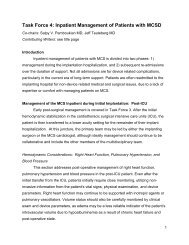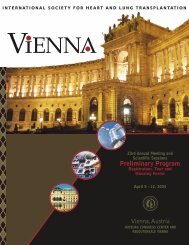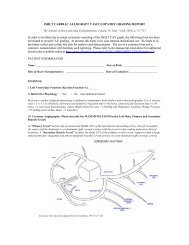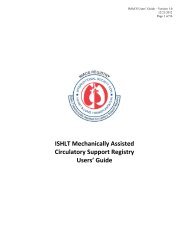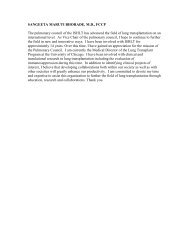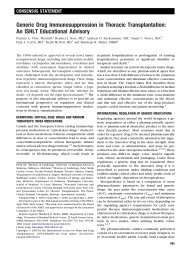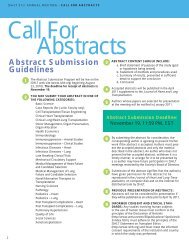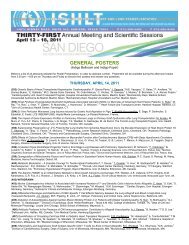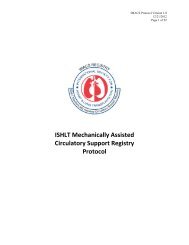Guidelines for the care of heart transplant recipients
Guidelines for the care of heart transplant recipients
Guidelines for the care of heart transplant recipients
You also want an ePaper? Increase the reach of your titles
YUMPU automatically turns print PDFs into web optimized ePapers that Google loves.
921<br />
Costanzo et al. <strong>Guidelines</strong> <strong>for</strong> Heart Transplant Care<br />
Adapted from Kobashigawa J, et al. 80<br />
Table 3 Examples <strong>of</strong> Desensitization Therapies<br />
Therapy Dose Frequency<br />
Plasmapheresis (A, F) 1.5 volume exchanges (A) 5 consecutive days<br />
(B) 5 times, every o<strong>the</strong>r day<br />
(C) 2–3 times/week until <strong>transplant</strong><br />
(D) 5 times, every o<strong>the</strong>r day, every 2–4 weeks<br />
Intravenous immunoglobulin (A, B) 2g/kg IV divided over 2 days<br />
(A) Every 2–4 weeks<br />
(IV Ig)<br />
(C) 2–3 g/kg IV divided over 4 days<br />
(D) 0.1 mg/kg IV<br />
(D) Every 2–4 weeks<br />
(E) 100 mg/kg IV<br />
(E) Every 4 weeks<br />
(F) 20 g (<strong>of</strong> 10% IV Ig)<br />
(G) 150 g (<strong>of</strong> 10% IV Ig) divided over 3 rounds (G) Every 4 weeks<br />
Rituximab (A) 1gIV (A)Weekly 4<br />
(C, E) 375 mg/m 2<br />
(C) 2 doses<br />
(G) 500 mg (E) Weekly 4<br />
(G) Every 2 weeks<br />
Cyclophosphamide<br />
(A) 1 mg/kg orally<br />
(A) Daily<br />
(used in <strong>the</strong> past)<br />
(C) 0.5 g/m 2<br />
(D) 1 mg/kg orally<br />
(A) UCLA; (B) Stan<strong>for</strong>d University; (C) University <strong>of</strong> Maryland; (D) University <strong>of</strong> Toronto; (E) University <strong>of</strong> Wisconsin; (F) Loyola University Chicago;<br />
(G) University <strong>of</strong> Berlin.<br />
via <strong>the</strong> hepatic cytochrome P-450 system (CYP3A). (3)<br />
Atovaquone (1500 mg PO QD). (4) Clindamycin and<br />
pyrimethamine.<br />
Level <strong>of</strong> Evidence: B.<br />
Recommendations <strong>for</strong> Peri-operative Infection Prophylaxis<br />
and Treatment in Pediatric Heart Transplant Recipients: 74–77<br />
Class IIb:<br />
1. IV anti-fungal prophylaxis should be considered <strong>for</strong> infants<br />
( 1 year <strong>of</strong> age) with an open chest and/or requiring<br />
ECMO support in <strong>the</strong> peri-operative period.<br />
Level <strong>of</strong> Evidence: C.<br />
2. Prophylaxis <strong>for</strong> Pneumocystis jiroveci should be instituted<br />
<strong>for</strong> a minimum <strong>of</strong> 3 months up to a maximum <strong>of</strong> 24<br />
months after HT.<br />
Level <strong>of</strong> Evidence: C.<br />
Topic 3: Evaluation <strong>of</strong> Allosensitization,<br />
Approaches to Sensitized Heart Transplant<br />
Recipients, and Hyperacute and Delayed<br />
Antibody-Mediated Rejection<br />
Recommendations <strong>for</strong> <strong>the</strong> Evaluation <strong>of</strong> Donor/Recipient<br />
Histocompatibility: 78–84<br />
Class I:<br />
1. Screening panel reactive antibodies (PRA) should be<br />
per<strong>for</strong>med in all HT candidates. When <strong>the</strong> PRA is elevated<br />
(10%) fur<strong>the</strong>r evaluation is recommended.<br />
Level <strong>of</strong> Evidence: C.<br />
2. The specificity <strong>of</strong> circulating antibodies should be determined<br />
with a solid-phase assay such as flow-cytometry,<br />
if possible, in a regional certified human leukocyte antigen<br />
(HLA) laboratory.<br />
Level <strong>of</strong> Evidence: C.<br />
3. The complement fixation capability <strong>of</strong> detected antibodies<br />
should be reported.<br />
Level <strong>of</strong> Evidence: C.<br />
4. The anti-HLA class I and II specificities (ie, any HLA<br />
antibody directed against HLA-A, HLA-B, HLA-Cw,<br />
HLA-DR, and HLA-DQ antigens) should be defined. In<br />
<strong>the</strong> absence <strong>of</strong> international standards, each <strong>transplant</strong><br />
center must define <strong>the</strong> threshold <strong>of</strong> antibody levels used<br />
to define which specific donor HLA antigens confer an<br />
unacceptable rejection risk.<br />
Level <strong>of</strong> Evidence: C.<br />
5. The virtual crossmatch, which compares recipient anti-<br />
HLA antibody specificities with donor HLA antigens,<br />
should be routinely used to increase <strong>the</strong> donor pool <strong>for</strong><br />
sensitized <strong>recipients</strong>.<br />
Level <strong>of</strong> Evidence: C.<br />
Recommendations <strong>for</strong> <strong>the</strong> Risk-Assessment and Prophylaxis<br />
Strategies <strong>for</strong> Allosensitized Heart Transplant Candidates<br />
80,85 :<br />
(See Table 3)<br />
Class IIa:<br />
1. A complete patient sensitization history, including previous<br />
PRA determinations, blood transfusions, pregnancies,<br />
implant <strong>of</strong> homograft materials, previous <strong>transplant</strong>ation,<br />
and use <strong>of</strong> a VAD is required to assess <strong>the</strong> risk <strong>of</strong><br />
<strong>heart</strong> allograft anti-body-mediated rejection.<br />
Level <strong>of</strong> Evidence: C.



